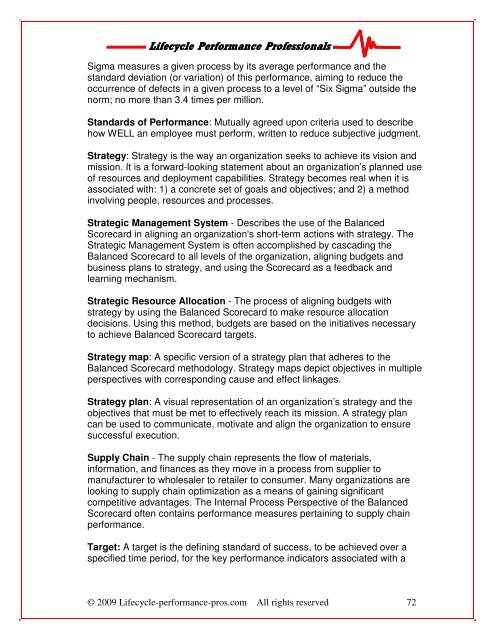Download the Performance Management Fundamentals Guide
Download the Performance Management Fundamentals Guide
Download the Performance Management Fundamentals Guide
You also want an ePaper? Increase the reach of your titles
YUMPU automatically turns print PDFs into web optimized ePapers that Google loves.
Lifecycle Lifecycle <strong>Performance</strong> <strong>Performance</strong> Professionals<br />
Professionals<br />
Sigma measures a given process by its average performance and <strong>the</strong><br />
standard deviation (or variation) of this performance, aiming to reduce <strong>the</strong><br />
occurrence of defects in a given process to a level of “Six Sigma” outside <strong>the</strong><br />
norm; no more than 3.4 times per million.<br />
Standards of <strong>Performance</strong>: Mutually agreed upon criteria used to describe<br />
how WELL an employee must perform, written to reduce subjective judgment.<br />
Strategy: Strategy is <strong>the</strong> way an organization seeks to achieve its vision and<br />
mission. It is a forward-looking statement about an organization’s planned use<br />
of resources and deployment capabilities. Strategy becomes real when it is<br />
associated with: 1) a concrete set of goals and objectives; and 2) a method<br />
involving people, resources and processes.<br />
Strategic <strong>Management</strong> System - Describes <strong>the</strong> use of <strong>the</strong> Balanced<br />
Scorecard in aligning an organization's short-term actions with strategy. The<br />
Strategic <strong>Management</strong> System is often accomplished by cascading <strong>the</strong><br />
Balanced Scorecard to all levels of <strong>the</strong> organization, aligning budgets and<br />
business plans to strategy, and using <strong>the</strong> Scorecard as a feedback and<br />
learning mechanism.<br />
Strategic Resource Allocation - The process of aligning budgets with<br />
strategy by using <strong>the</strong> Balanced Scorecard to make resource allocation<br />
decisions. Using this method, budgets are based on <strong>the</strong> initiatives necessary<br />
to achieve Balanced Scorecard targets.<br />
Strategy map: A specific version of a strategy plan that adheres to <strong>the</strong><br />
Balanced Scorecard methodology. Strategy maps depict objectives in multiple<br />
perspectives with corresponding cause and effect linkages.<br />
Strategy plan: A visual representation of an organization’s strategy and <strong>the</strong><br />
objectives that must be met to effectively reach its mission. A strategy plan<br />
can be used to communicate, motivate and align <strong>the</strong> organization to ensure<br />
successful execution.<br />
Supply Chain - The supply chain represents <strong>the</strong> flow of materials,<br />
information, and finances as <strong>the</strong>y move in a process from supplier to<br />
manufacturer to wholesaler to retailer to consumer. Many organizations are<br />
looking to supply chain optimization as a means of gaining significant<br />
competitive advantages. The Internal Process Perspective of <strong>the</strong> Balanced<br />
Scorecard often contains performance measures pertaining to supply chain<br />
performance.<br />
Target: A target is <strong>the</strong> defining standard of success, to be achieved over a<br />
specified time period, for <strong>the</strong> key performance indicators associated with a<br />
© 2009 Lifecycle-performance-pros.com All rights reserved 72










